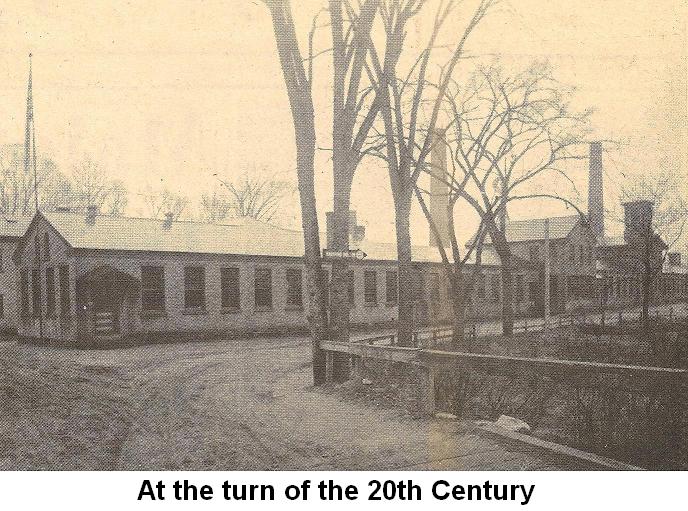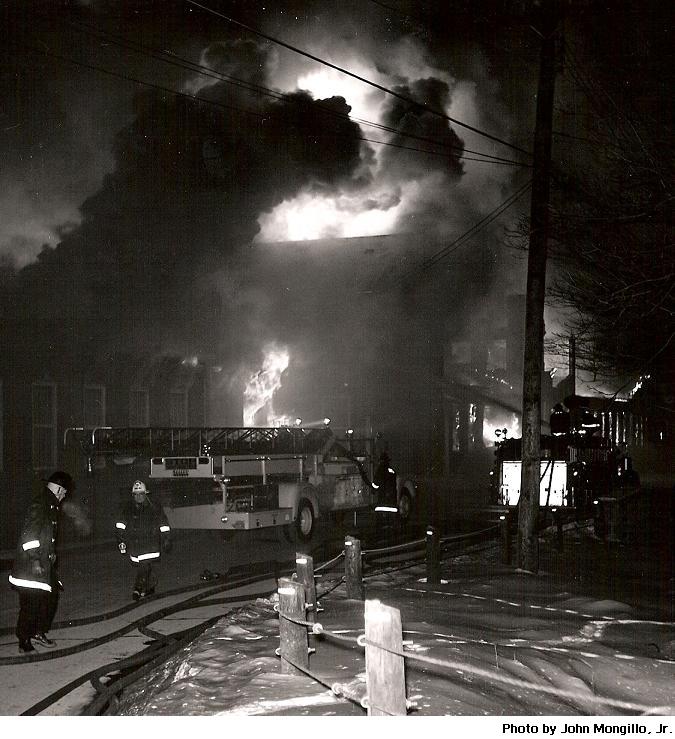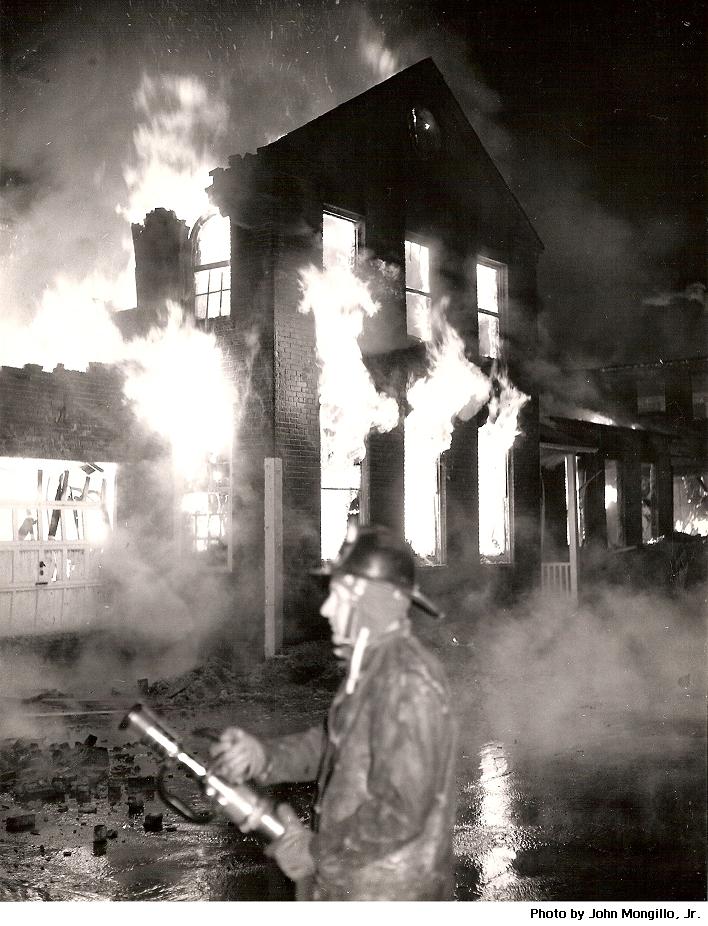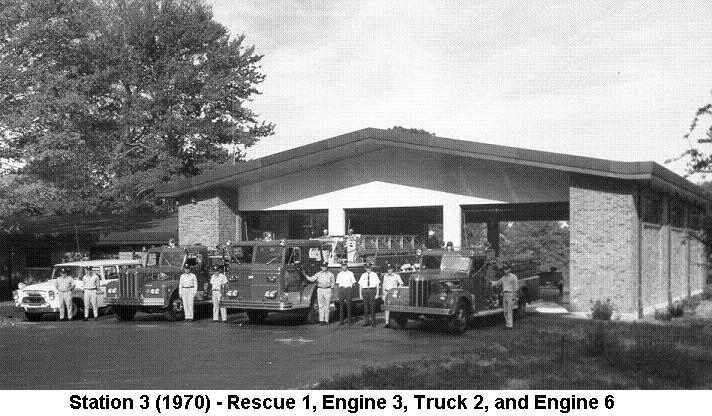|
 The following article is a historical account of the Fleming Company Fire in January 1968. It is being published in this forum in it's entirety, and was written by HFD Retired Captain David G. Johnson. Captain Johnson maintains a collection of HFD memorabilia, including news articles, photographs, and personal accounts of historical events given to him by retired members of our department. Brother Johnson is an invaluable resource in maintaining the history and fine traditions held by the Hamden Fire Department. The following article is a historical account of the Fleming Company Fire in January 1968. It is being published in this forum in it's entirety, and was written by HFD Retired Captain David G. Johnson. Captain Johnson maintains a collection of HFD memorabilia, including news articles, photographs, and personal accounts of historical events given to him by retired members of our department. Brother Johnson is an invaluable resource in maintaining the history and fine traditions held by the Hamden Fire Department.
Any views expressed in this article belong soley to our retired brother, and it may not be reprinted, re-transmitted, or republished in any other forum without the express written consent of the Hamden Professional Firefighters.
Major fire launches a transitional year for the Hamden Fire Department by David G. Johnson, HFD Retired.
It has been forty years, but Jean Law will never forget the early morning hours of Friday, January 12, 1968, when she was wakened by loud voices outside her South New Road home. Peeking out her front picture window, Jean didnt see any people, only a huge orange glow reflecting on the houses across the street. But it was a different story when she looked out her rear window through the leaf-bare trees across Mill River to Broadway. Now well into her eighties, Jean easily recalls how she sat by the window that morning, watching one of the most spectacular blazes in Hamden history.

According to newspaper accounts, as well as recollections from firefighters who were there, a truck driver heading north on Ridge Road at about 3:45 that morning noticed a glow in the sky. Checking it out, the man drove his truck down Broadway to the George W. Fleming Co., where he found the south end of the rambling 133-year old brick building fully involved. He was the only spectator.
The truck driver then raced up Ives to Whitney and pulled onto the ramp at Station 5. In those somewhat simpler times Hamden firehouses were always unlocked, so the guy had no trouble getting inside. He ran to the watch desk, picked up the house phone and began barking Fire! over the loud speakers of every fire station in town.
Firefighters Mario Bucky Serafino and Gerry Wolf, who had been asleep upstairs at Station 5, were able to relay further details to dispatcher Wilbur Baker over the inside PBX line. Baker immediately dispatched Bucky and Gerry on Engine 5, as well as Engine 4, Ladder 1 (at Station 2), Rescue 2 (at Station 4), and then toned out the volunteers of Co. 5.
The New Haven Register reported, When the first company reached the scene, the fire was surging through the roof and lashing along the sides of the structure. Fire Chief V. Paul Leddy had no trouble seeing the conflagration from his Cumpstone Drive home. He immediately ordered a second alarm, which brought Engine 2 from Station 2, Engine 3 and Rescue 1 from old Station 3 on Putnam Avenue, as well as additional volunteer companies 7 and 9. North Haven dispatched a pumper from their West Ridge station.

According to an account in The Hamden Chronicle, the building had been erected in 1835 by James Ives as the Mt. Carmel Brass Works. Later, it was occupied by W. Woodruff and Sons, which manufactured various hardware items during the early half of the 20th Century.
At the time of the fire, the principal occupant of the building was the George W. Fleming Co., manufacturers of cutlery. However, the manufacturing end of the business had moved to Wallingford only a few months earlier. By the time of the fire, the Fleming Co. portion of the building was being used only as a warehouse for their
products. The Ives Street end of the building complex previously housed the Sterling Beverage Co. By January 1968, Sterling Beverage had rented their part of the building to the Cott Beverage Co. of New Haven for storage.
With the building well involved when the first apparatus arrived, the main objective was saving the undamaged portions of the structure, as well as protecting the adjacent exposures on Broadway. The home of the Rexford Barnes family, right next door at 40 Broadway, was only about twenty feet from the southern end of the building.
It was a bitter cold night, with temperatures hovering around zero. Parallel 2½ water supply lines were pumped from a 3-way hydrant on Ives Street near New Rd. Two ancient 2-way hydrants were located further down Broadway at #58 and #100, and at least one of them was frozen. The Register reported, Hose lines were stretched to nearby Mill River in order to pump water, but Chief [V. Paul] Leddy noted that firemen had some difficulty with pumps freezing intermittently.
Retired Battalion Chief Thomas Doherty, a seven-year veteran at the time, recalls having been recently transferred from Headquarters (now Station 4) to Station 2, where he was assigned to drive Ladder 1, a 1958 Maxim 75-foot aerial ladder truck. When the alarm sounded, Firefighters Doherty and Bill Mulcahy responded from Station 2 in the open-cab truck in sub-zero temperatures. Today, Chief Doherty recalls that by the time they got to the fire they were both frozen stiff. They were ordered to set up the aerial ladder pipe to protect the Ives Street end of the building, which was saved and remains standing to this day. Despite the intense radiant heat and flying brands, efforts to protect the Barnes home and the other homes immediately south of the building were successful, as well.
Firefighters Ed Doiron and Mickey Cantarella were on Engine 6 at 21 Merritt Street. The only paid company left in service, they relocated to Station 3 on Putnam Avenue to cover the town with Volunteer Co. 8. [NOTE: No career firefighters were assigned to Co. 9 until the new Station 9 was opened in December 1968.]
The shift commander was Deputy Chief Joseph Hromadka [seen in the photo above, wearing the white helmet], who told the Register that the blaze was one of the largest that he could remember in his 32 years on the Department. Deputy Chief Hromadka was one of the original two shift commanders to be appointed from among the ranks of the career firefighters when the Department was reorganized with paid officers in 1942. Deputy Chief Hromadka retired in 1972. For many years thereafter, he was a frequent visitor at Station 4, unitl his death in November 1986 at age 72.

Having joined Volunteer Co. 5 in October 1966, I did not yet have a Plectron radio, the dinosaur plug-in ancestor of todays pagers. So, after two morning classes at SCSC, I finally got to the scene well after the fire had been knocked down, but just in time to help roll up the hundreds of feet of 2½ that had spaghettied all over Broadway.
As I recall, the firefighters on Engine 5 that day shift were Robert Ace Callahan and Ray Carofano. Once the hose was rolled up, a fellow Co. 5 volunteer, Bill Kelly, and I rode Engine 5 to Station 2 to help change hose. This was my first ride on a tailboard. When we arrived at 2s, the paid guys were only too happy to let us assist in repacking Engine 5 with 1,000 feet of fresh 2½. We were eager to pitch in and learned how to keep the end folds even. This was still a couple of years before all hose beds were split into separate bays of 2½ and 3 hose for parallel lays, and seventeen years before the introduction of large diameter hose.
Some modern historians say that 1968 was a transitional year for America. On a somewhat smaller scale, 1968 was also a transitional year for the Hamden Fire Department. At the time of the Fleming Company fire in January, Engine 1 was a 1938 Seagrave 600 g.p.m. pumper at Station 2 the Departments spare. Engine 2 was a 1959 Maxim cab-forward 750 g.p.m. pumper. Engine 3 was a 1954 Maxim 750 g.p.m. pumper. Engine 4 was a 1965 Mack 750 g.p.m. pumper, the Departments first commercial bodied apparatus since the Diamond-T engines of the early 1940s. And Engines 5 & 6 were identical 1951 and 1952 Maxim 750 g.p.m. pumpers.
In 1968, Hamdens first paid Fire Marshal, Al Purce, and the first Superintendent of Alarms & Apparatus, Clem Wetmore, were both nearing retirement but were still on the job. The Departments only ladder truck was the aforementioned 1958 75-foot Maxim Junior Aerial at Station 2. The rescue units this was three years before Hamdens first group of EMTs were 1958 and 1960 International Travelalls, similar to todays Chevy Suburbans. Both rescues, Engine 2 and Ladder 1 were still white, as when delivered in the late 50s.
By the end of 1968, the Town had purchased two new 1,000 GPM S-model Maxim pumpers. On December 8th, Station 9 opened with one paid man on each of the three platoons assigned to the 1951 Maxim pumper. By the end of 1968, Marshal Purce and Supt. Wetmore had retired. They were replaced by Captain Bob Bubby ODonnell and Asst. Supt. Richard Lostritto, respectively.
Also in 1968, the Town and the Hamden Paid Firemens Sick Benefit Association, which had become the bargaining unit for non-management fire personnel, agreed on the implementation of a 42-hour workweek to commence on October 5, 1970. Since 1951, line personnel had worked an average of 56 hours a week (four days on, two days off, etc.).
Old Station 3 and Station 6 were closed when new Station 3 at Hartford Turnpike and Ridge Road opened in November 1970. The new station housed Engine 3, Engine 6, Rescue 1, the Deputy Chief (shift commander), and a second truck company, Ladder 2, a new 1970 Maxim 100-foot aerial truck.

The 1958 Maxim 75-foot aerial ladder truck remained at Station 2 until April 9, 1976, when it was transferred to occupy Station 5s new annex built the previous year. In 1985, now designated Truck 2, it was transferred to Station 9. By 1988, it was removed from service and became a spare, and the 1970 100-foot aerial ladder truck, now designated Truck 1, became the Departments only truck company. The 1970 truck was retired in the early 1990s with the acquisition of the Tower and Truck 1.
Both of the white International rescue trucks were removed from service in 1971 when the Departments first modular unit, Rescue 1, was assigned to Station 4. The ornate gold leafing that decorated the new 1971 Ford cab and box resulted in the somewhat whimsical, if not affectionate nickname the Circus Wagon. For the next several years, Engine 2 handled rescue calls in the south end of Hamden. With the introduction of paramedic service, Rescue 2, on a 1975 Ford chassis, went in service at Station 2 on April 9, 1976.
Engine 6 remained in service briefly after Station 3 opened, but was deactivated shortly thereafter when Engine 1 was reactivated at Station 2. By the mid-1970s, the 1959 Maxim cab-forward was designated as Engine 6, the Departments permanent spare pumper. It was repowered with a new diesel engine in 1981 and remained in service until the early 1990s.
Captain David G. Johnson, HFD Retired [Interested parties may write to Captain Johnson at HFDBadge102@aol.com.]
|




